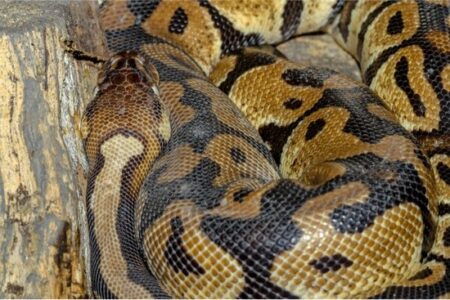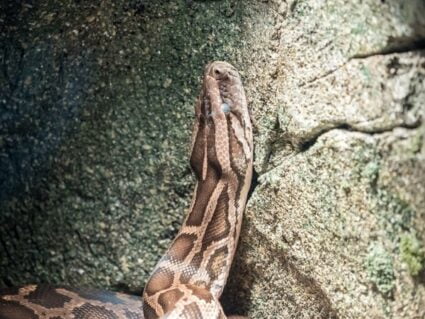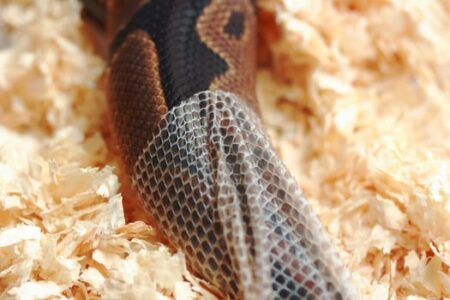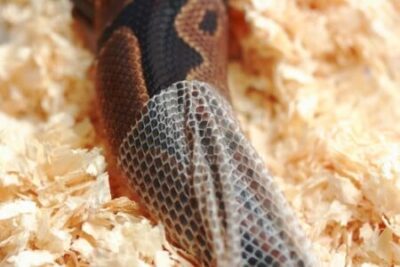All snakes shed their skin (ecdysis). Ball pythons get rid of their skin all at once to accommodate new growth, whereas the skin comes off other mammals in tiny pieces. It’s vital that you understand how the ball python shedding process works, and can deal with any problem sheds.
Ball pythons go through a pre-shed stage that lasts for 1-2 weeks. Their skin will become dull and dark, and their belly may appear pink. When they enter the “blue phase,” their eyes will appear milky-blue due to a buildup of fluid. This clears up, and your ball python will shed its skin within 72 hours.
We’ll detail the ball python shedding cycle from start to finish. We’ll then explain how your snake’s behavior might change. You’ll also find out how often ball pythons shed, and how to fix a stuck shed on your ball python’s head or eyes if a problem was to arise.
Why Ball Pythons Shed Their Skin
Skin cells are continually dying and being replaced by new ones. Snakes get rid of their skin all in one go, which is a process called ecdysis.
Snakes do not stop growing once they reach adulthood. Their bodies continue to increase in size throughout their lives. They grow quickly while they’re young, and slow down once they reach maturity.
A snake’s skin isn’t very stretchy. So, in order to make room for any new growth, they must cast off their old skin and start afresh.
Growing continuously gives wild snakes an advantage. The bigger they are, the less likely they are to get eaten by predators. For female snakes, being bigger, allows her to carry more eggs, helping her bloodline to survive.
According to Proceedings (Biological Sciences), shedding the skin after parasites become attached helps to remove them.
Snake mites and ticks can be a life-threatening health problem for wild snakes, and regularly affect pet snakes. Shedding is one of the ways that snakes have evolved to get rid of parasites.
Ball Python Shedding Timeline
There are 4 stages to the ball python shedding process. The process usually lasts between 1 and 2 weeks, culminating in full removal of a snake’s skin.
Color Change
When it’s time to shed, you’ll notice your ball python’s colors becoming darker and more faded than normal.
You may also notice your snake’s eyes becoming darker at this time. Depending on what morph your ball python is, it may look almost black or have a duller-than-normal appearance.
Some ball pythons’ undersides display a pinkish hue during this stage. This is referred to as “pink belly.”
During this stage, your ball python may lose its appetite. This is normal. Don’t feed your snake until after the shed is complete.
Blue Phase
The second pre-shed stage is called the “blue phase,” also referred to as “being in blue.”
During the blue phase, your ball python’s eyes will appear a cloudy, milky blue color. This is due to a layer of fluid building up between the snake’s old skin, and fresh new skin. Its skin will also appear much duller than it did during the previous stage. It may even have a blue tint to it.
This stage can be quite stressful for your ball python. You may observe the common ball python shedding behavior of hiding. Do not handle your snake from this point onwards as your snake could become defensive.
It’s advisable to increase the vivarium’s humidity to 60-65% at this point. The extra moisture will help your snake to shed its skin. You can also introduce a “humidity box” filled with damp sphagnum moss.
Pre-Shed Clear Up
After your ball python has been in blue for around 3-5 days, your snake will start to look normal again.
The fluid between the old and new skin will go away. You’ll no longer see a milky blue tint to its eyes, and the skin will regain its color.

Shedding the Skin
Your ball python will start to shed its skin about 24 to 72 hours after the pre-shed clear up. Snakes usually shed their skin during the night, so you may not ever see it happening.
- Your ball python will nudge its nose up against something in its enclosure. This could be a rock, piece of wood, or the side of the tank. This will create a small tear in the skin.
- When the skin has begun to peel, your ball python will start moving around, rubbing up against anything it can find to encourage the skin to come away.
- If you manage to see your ball python in the middle of a shed, you might notice what looks like a rolled-up sock halfway down its body.
- After 1-2 hours of shedding, the process is complete. Your ball python will look shiny, glossy, and bright again.
You’ll find a long piece of skin somewhere in the enclosure. It should be in one piece, complete with eye-caps and a tail tip.
Will a Ball Python Eat While Shedding?
This will vary for each snake. Some ball pythons will not eat at all, from the first stage of pre-shed until the skin has come off. Appetite loss is common during shed, and you should not worry about it.
Some ball pythons will take food during the shedding process. However, we would not recommend feeding your snake while in a shed. Here’s why:
- Poor eyesight. During the blue phase, your ball python cannot see very well. Introducing food can be stressful as the snake can’t see the prey. If you feed it live prey, this can lead to injury. Feeding frozen-thawed is safer, but your snake could mistake your hand for food.
- Regurgitation risk. Sometimes, ball pythons that are fed during the shedding process will regurgitate food. This is because shedding requires a lot of movement.
According to Zoology, ball pythons can go for months without food before they lose weight.
The entire shedding process of a ball python takes less than 14 days. If you wait until your snake has finished shedding its skin before feeding it, a healthy snake will be just fine.
Are Ball Pythons Aggressive When Shedding?
When ball pythons go through the blue phase, they’re virtually blind. The layer of opaque fluid between their old and new skin covers their eyes. It can be stressful for any snake to lose its sight as it feels vulnerable.
You’ll notice your ball python behaving differently when it goes into a shed. It’s common for snakes to become reclusive, and remain in their hide boxes all day long. This is to avoid detection by potential predators.
During this process, your ball python probably won’t want to be handled. Your snake will find it very stressful. Handling your snake when it’s shedding may prompt it to recoil away from you, hiss, or strike out of fear.

How Often Do Ball Pythons Shed Their Skin?
Now that you know how the shedding process works, how often you should expect this to happen depends on 2 factors:
- Age. Ball pythons shed due to their growth. The larger body size requires a larger skin, so they slough off the smaller skin to make room. Juvenile ball pythons grow much faster than adults, so they’ll shed more frequently.
- Growth. The more your ball python eats, the faster it’ll grow. If it’s a good eater, it will shed more often than a ball python that eats less frequently. Also, some snakes will naturally grow faster than others, regardless of how often they eat. It’s all down to the snake’s genetics.
Juvenile ball pythons (under 1-year-old) shed regularly. If you’re wondering: “why is my ball python shedding so much?” it’s due to its age. Up until your ball python is a year old, it’ll shed once every 3-4 weeks.
Once your snake reaches around 700 to 1000 grams in weight, its growth will slow down a lot. Adult ball pythons shed once every 6-8 weeks.

Why Is My Ball Python Not Shedding?
If your snake isn’t shedding, here’s why:
- Age-related. Older snakes shed much less frequently than younger snakes. If your snake is approaching the one-year mark, it’ll naturally start to shed with decreasing frequency.
- The vivarium is too cold. Wild ball pythons go into a state of reduced activity during the winter months. They don’t quite hibernate, but they definitely move and eat less. It’s not unusual for ball pythons to stop shedding in the colder months. Use a thermometer to ensure that the temperature does not fall below 78 degrees Fahrenheit.
- Not feeding it enough. Give your ball python a prey item that is just slightly wider than your snake’s width at its widest point. Feed it at least once a week while it’s young, and every 2-3 weeks as an adult.
Keep track of when your ball python sheds, and how long it goes between shedding. If you are concerned, take it to a vet experienced with snakes.
How to Resolve Ball Python Shedding Issues
Sometimes, ball pythons have trouble shedding. If you notice stuck pieces of old skin clinging to your snake or stuck eye caps, then the vivarium’s humidity was probably set too low.
To encourage the stuck shed to come away, you should bathe your ball python. Snakes can swim, so don’t worry. Fill a plastic tub with about two inches of water at around 80 to 85 degrees Fahrenheit. Put your snake inside the tub and leave it there to soak for about 20 minutes.
After her bath, take a warm, damp washcloth and run it over your snake from head to tail. You should notice the stuck shed starting to come away. To remove the eye cap, use a damp cotton bud and wipe it over the eye.
Don’t worry if you can’t get every piece of shed off. It will naturally come away the next time your snake sheds. Just make sure that your ball python has the right level of humidity in the future.

